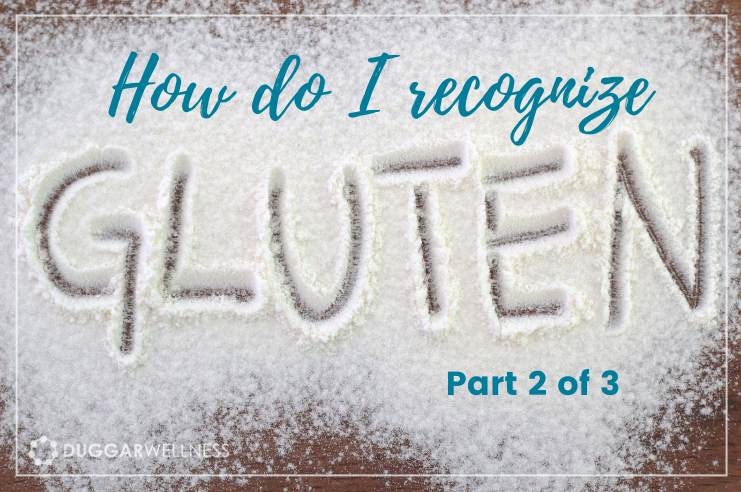Should I avoid gluten? This is a question that I have answered in a 3 part series of posts. Part 1 was titled: Should I Avoid Gluten? This post is all about the question: How do I recognize Gluten?
As a general rule when adopting a gluten-free diet you should avoid all baked goods like bread, cakes, pies, cookies, and crackers as well as pasta. There is a learning curve to knowing and recognizing grains that contain gluten or foods that contain gluten-containing ingredients.
What foods should I avoid?
Grains to Avoid:
Wheat Flour: white flour, enriched flour, whole wheat flour, and self-rising flour
Barley
Rye
Wheat Starch, Wheat Bran, Wheat Germ
Cracked Wheat
Hydrolyzed Wheat Protein
Durum Flour
Farina Graham Flour
Semolina
Couscous
Triticale–a cross between wheat and rye
Spelt
Kamut
Orzo
Seitan– Vegetarians “Wheat Meat”
Hidden Sources of Gluten
90% of gluten is found in the foods listed above. The other 10% is found in hidden sources. These sources generally come from processed foods. Wheat is often used as a filler or thickener.
These items often contain wheat:
Alcoholic Beverages (Beer, whiskey, and grain alcohols are made from wheat, barley & rye)
Bouillon cubes
Candy (Hard candy or gum is often dusted with flour to prevent sticking)
Deli Meats
French Fries and other deep-fried foods- these are often dusted with wheat or cross-contamination occurs with other fried foods.
Frozen or pre-packaged meals
Glazed ham, marinated meat, and self-basting turkey
Gravy
Ice Cream
Imitation fish/crab
Oats: (Oats are by nature gluten-free but many are cross-contaminated due to being processed in plants that also process wheat. Only purchase certified gluten-free oats.)
Seasoned Potato or tortilla chips
Rice mixes
Sauces
Seasoning Packets and Spice Blends
Salad Dressings
Creamed soups
Soy sauce
Condiments
Non-Food Items: make-up, shampoos, and lipstick or lip balm
The Importance of Reading Labels
As you have just read there are lots of foods that contain gluten. Reading labels must become a new part of everyday life unless you remove all processed foods from your diet. We need to read labels at the grocery store and reread them again before opening a can, box, or package at home. Manufacturers often change ingredients so, we must read labels over and over and over again, even when purchasing products we think are safe.
When reading labels look for “Gluten-Free” on the label, “Contains Wheat” in the allergen section of the label, “May Contain Traces of Wheat” and “Processed in a Gluten-Free Facility” or “Processed in a facility that also processes wheat” on the label.
Ingredients that Contain Gluten
Artificial color
Baking powder
Caramel color/flavoring
Dextrins
Diglycerides
Emulsifiers
Enzymes
Fat replacers
Flavorings
Citric acid: (can be made by fermenting wheat, corn, molasses or beets)
Glucose syrup
Glycerides
Hydrolyzed Vegetable Protein
Malt
Maltodextrin
Modified food starch
Natural juices
Stabilizers
Starch
Vegetable Protein
Keep a list of gluten-containing ingredients with you. Make a list on your phone or tucked into your wallet so that you can use it as a reference when shopping until you easily remember what to look for on ingredient lists.
For some real-life strategies check out the post titled: How do I replace gluten?
 140 N Main, Bountiful, UT 84010
140 N Main, Bountiful, UT 84010  801-677-7878
801-677-7878


3 responses to “How do I recognize gluten? Part 2 of 3”
[…] you want to continue reading and learning about gluten? See Part 2: How do I recognize gluten? and Part 3: How do I replace […]
[…] 3 part series of posts. Part 1 was titled: Should I Avoid Gluten? Part 2 answered the question: How do I recognize Gluten? This is Part 3 of the series that will help you replace gluten containing foods and […]
[…] you want to continue reading and learning about gluten? See Part 2: How do I recognize gluten? and Part 3: How do I replace […]